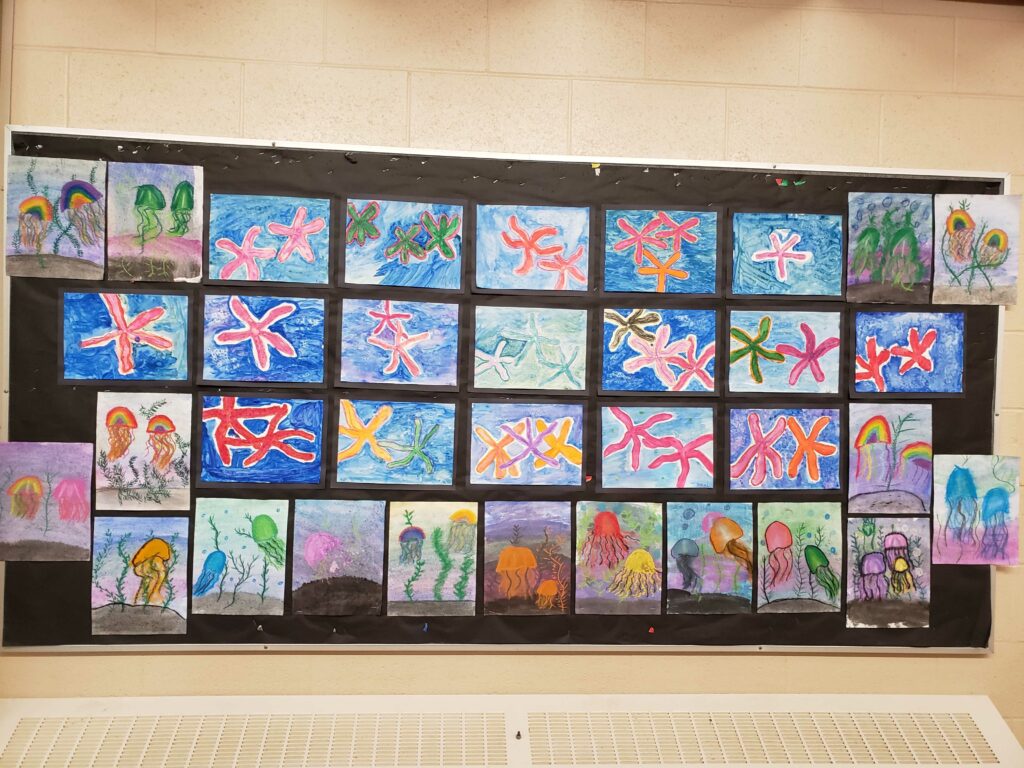Educators implement effective planning, instruction, assessment and reporting practices to create respectful, inclusive environments for student learning and development.
One instant in which I planned for differentiation in my teaching was during my EDUC 490 practicum, in an art lesson for my grade 5s. The goal of the lesson was to create pictures of jellyfish underwater using watercolours and oil pastels.
Before the lesson, I drew the basic concepts on the board – the shape of the jellyfish with step by step instructions, and the same for the seaweed and the watercolour background. This was to give students a visual to refer back to whenever they needed during the lesson.
I began the lesson by walking through examples with the students. We started with the watercolour background, and I walked them through blending watercolours to get their background to look like an ocean, asking students to raise their hands and let me know if they had any questions. They were then free to use the different colours and paintbrushes to create their backgrounds to their own content.
Some students did this quickly and efficiently. Some took their time. Some used only one or two shades or colours, and others created an oceanic rainbow.
I circulated the classroom during this stage, and helped where I was needed. This class had a student with autism, who was fully capable of completing this activity, but who needed more direct instructions to get it done. I brought him up to the front of the classroom where my exemplar was hanging and showed him how the different colours work together, and he thought he was able to do that, so I left him at his desk to work on it. By the time I circulated back, he’d created an ocean-esque watercolour background. He’d taken the initiative to ask his neighbour for pointers in blending, and his background looked just as good as the rest of the class.
We let the watercolours dry. After lunch, I had students collect blank pieces of paper and oil pastels, and I walked them through how to draw the other elements of the picture. My CT had a document camera – something I think I will need to invest in for my future classroom because it came in really handy for a lot of lessons – so I put my own paper under that, and walked the students step by step through how to create their pictures. We started with the jellyfish, arguably the hardest part, and went through the different steps for drawing and blending, and where and when to use which shades of their pastels. The students were able to ask questions, get me to repeat steps, and anything else they needed during this stage. We repeated this process with seaweed and bubbles. At the end of this instruction, most of the students were confident to begin working on adding these elements to their watercolour pictures.
Two students were not at all confident with moving onto their final copies, so I had them bring their chairs and new blank pieces of paper up to my desk at the front, and we ran through a few more examples. I showed them how to do the parts they were confused on, and they asked me more specific questions, and, after a couple run throughs, they were confident enough to return to their desks and start on their own.
After that, I circulated the classroom, watching them create their unique pictures. I had started to help the student with autism go through the steps to draw a jellyfish, but another student came up with his finished project and was excited to help walk this student through the steps.
By the end of the lesson – some students finished this part within twenty minutes, some took closer to the hour I’d scheduled this into our day – every student had a unique finished art project. Some had only one jellyfish, some had multiple. Some added other elements. Some had their jellyfish in shades of the same colour, and others made them multicolour.
Despite the different levels of instruction each student needed, they were all able to create amazing projects. This was thanks to the work I put into planning and differentiating my instruction as needed for this to work best for all of my students.
